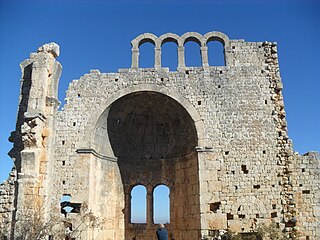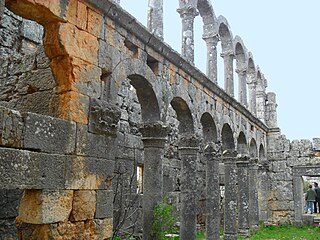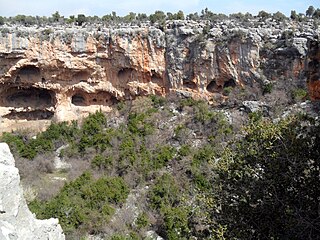
Meydancık Castle is a castle ruin in Mersin Province, Turkey. The original name was Kirshu and the name of the ruin during Ottoman times was Beydili Kale.

The Üçayaklı ruins are a Byzantine-era archaeological site in Mersin Province, Turkey.

Tokmar Castle is a castle ruin in Mersin Province, Turkey

Mezgitkale is a 2nd- or 3rd-century mausoleum in Mersin Province of Turkey.

Tekfur ambarı is a large cistern in Silifke ( Seleukeia) ilçe district center of Mersin Province, Turkey. A part of the city of Silifke, it is situated to the west of city center and to the east of Silifke castle at 36°23′N33°55′E. It was built during the early years of Byzantine Empire. The building material is face stone. The west to east dimension is 46 metres (151 ft) and the north to south dimension is 23 metres (75 ft). The depth of the cistern is 14 metres (46 ft). The total water capacity is about 12 000 tonnes. At the east side of the cistern there is a spiral staircase. There are 8 niches at the 46 m dimension and 5 niches at the 23 m dimension.

Mancınık Castle is a Hellenistic castle ruin in Mersin Province, Turkey. Its original name is unknown.

Silifke Museum is in Silifke district of Mersin Province, Turkey.

Öküzlü is an archaeological site in Mersin Province, Turkey.

Yanıkhan is an archaeological site in Mersin Province, Turkey. It is about 5 kilometres (3.1 mi) northwest of Limonlu town. It is to the east of Limonlu-Esenpınar road and west of Limonlu River at about 36°35′N34°12′E. Its distance to Erdemli is 18 kilometres (11 mi) and to Mersin is 54 kilometres (34 mi).

Karakabaklı is an archaeological site in Mersin Province, Turkey.

Cambazlı is an archaeological site in Mersin Province, Turkey

Akhayat is a sinkhole in Mersin Province, Turkey.

Boğsak is a Mediterranean islet in Mersin Province, Turkey.

Meydankale is the archaeological site of a ruined castle in Mersin Province, Turkey.
Anamur Museum is a museum of archaeology and ethnography in Anamur ilçe (district) of Mersin Province, southern Turkey.

Narlıkuyu Mosaic Museum is a small museum in Narlıkuyu, Turkey that encompasses a Roman bath with a mosaic tile floor. The mosaic depicts the Three Graces.

Yılanlı Ada is a small Mediterranean island in Turkey.

Işıkkale is an ancient settlement in Turkey.

Uzuncaburç is an archaeological site in Mersin Province, Turkey, containing the remnants of the ancient city of Diokaisareia or Diocaesarea.

Tekkadın ruins are a group of ruins in Mersin Province, Turkey. The name of the ruins is a local name meaning "single woman". The original name is not known. The ruins are in the rural area of Silifke ilçe (district) of Mersin Province at 36°29′19″N34°00′27″E. The visitors follow Turkish state highway D.400 and turn north in Atakent town. The ruins are about 11 kilometres (6.8 mi) to Atakent. Distance to Silifke is 27 kilometres (17 mi) and to Mersin is 77 kilometres (48 mi).




















